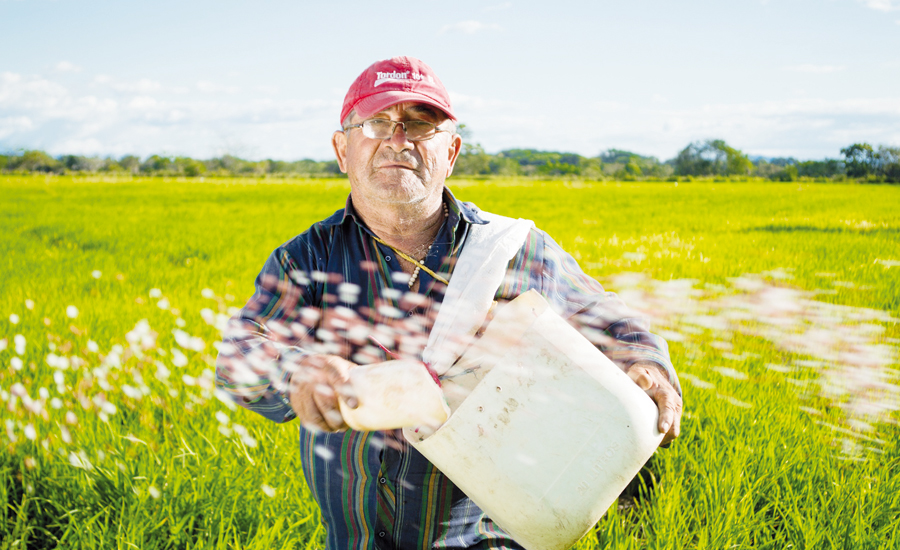

As farmers worldwide experience more frequent drought and erratic rainfall linked to climate change, the race to find and improve drought-resistant crops grows ever more important.
In recent decades, research has increased to see how food crops cope with dry conditions, and scientists are breeding and crossing seeds to make them more drought-tolerant.
But major obstacles exist in scaling up their use.
“Getting new crop varieties into the hands of a large number of farmers quickly is the challenge,” said Robert Asiedu, head of biotechnology and genetic improvement at the International Institute of Tropical Agriculture, a research centre based in Nigeria.
“It can be five to 10 years before large quantities of new varieties reach farmers... That’s the main bottleneck now.”
It is crucial for farmers to grow drought-resistant crops as part of a range of pro-active measures, experts say.
For example, soil degradation and deforestation exacerbate the effects of drought because soil loses its ability to retain water, so farmers must improve soil fertility and irrigation practices.
Below are some of the drought-tolerant crops and methods farmers across the world are using to combat drought:
1. INTERCROPPING
Staple food crops like sorghum, cassava, sweet potato, pearl millet, cowpea and groundnut are naturally more drought-tolerant than maize.
For centuries, farmers in parts of West Africa have grown maize alongside cassava and sweet potatoes.
The practice known as intercropping - growing two or more crops together - means farmers have another crop to fall back on when maize harvests fail because of poor rainfall.
Intercropping was introduced to maize farmers in East Africa in the 1990s.
2. COWPEA
Cowpea, also known as black-eyed pea, is mainly grown by small farmers in more than 80 countries, from Nigeria to Brazil.
Cowpea thrives in parched soils and drought-prone areas where its roots can grow with as little as 300 mm (11.8 inches) of rainfall per year. Once cowpea seeds have enough moisture to take root, the plants can survive drought.
The stems and stalks of the high protein grain can also be used as fodder for livestock.
Often intercropped with maize and cotton, cowpea plants provide shade and dense cover that help protect soil and preserve moisture.
Researchers are trying to map the genes found in cowpea to produce improved drought-resistant varieties.
3. CHICKPEA
Chickpea is one of the most important grain legume crops in the world. Thanks to its drought resistance, it is widely grown among small farmers in dryland areas of South Asia and in China.
Scientists in Australia are leading the way in research to enhance drought tolerance in chickpeas and to better understand how the food crop adapts to prolonged dry spells.
4. EARLY MATURING CROPS
Shifting rainfall patterns, often linked to climate change, have shortened the rainy season in many countries worldwide.
Hardest hit are small-scale and subsistence farmers as they largely depend on rain-fed crops for their livelihoods.
To adapt, farmers are increasingly planting new varieties of food crops that take less time to grow.
New varieties need 90 to 110 days to mature - against 120 days plus for traditional crops - and can survive without rain for three weeks.
In recent years, early-maturing food crops have been adopted by tens of millions of farmers in sub-Saharan Africa.
5. ANCIENT PLANTS
Chia, a flowering plant, is grown for its edible seeds and is known to thrive in hot and dry weather.
Once widely grown by the ancient Aztecs of Central America, chia is being rediscovered by small farmers across Latin America, including Guatemala, Bolivia, Nicaragua and Ecuador.
High in protein, chia seeds can be eaten whole, ground into flour and pressed for oil.
6. TARWI
With its brilliant blue blossom, the tarwi pea plant stands out from the rest in the field.
Once grown centuries ago by the Incas, more Andean subsistence farming communities, particularly in Bolivia’s highlands, are growing tarwi again.
The drought-resistant seeds are nutritious, high in protein and a source of cooking oil.
7. NEW MAIZE VARIETIES
Maize is one of the world’s most important cereal crops.
In the past decade, farmers - especially in sub-Saharan Africa - have tried new strains that can withstand drought, allowing crops to grow when there is little or no rain.
Maize has also been genetically modified to include the desired DNA traits that thrive in drought conditions.
A 2010 study found that the widespread adoption of drought-tolerant varieties could boost maize harvests in 13 African countries by 10-34 percent. — Thomson Reuters Foundation
Sources: FAO, global research partnership CGIAR, World Bank, Bill & Melinda Gates Foundation
Oman Observer is now on the WhatsApp channel. Click here



